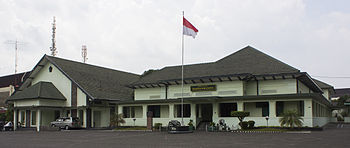People's Security Army
| People's Security Army | |
|---|---|
| Tentara Keamanan Rakyat | |
| Founded | 5 October 1945 (formerly called the People's Security Agency which was formed from former KNIL and PETA) |
| Disbanded | 26 January 1946 |
| Headquarters | Yogyakarta |
| Leadership | |
| Minister of Defense | Amir Sjarifoeddin[1] |
| Commander | General Soedirman |
| Related articles | |
| History | Indonesian War of Independence |
| Ranks | Rank of the People's Security Army |
The People's Security Army (Indonesian: Tentara Keamanan Rakyat) or commonly abbreviated as TKR is the name of the first military force formed by the Indonesian Government, after the Proclamation of Indonesian Independence. TKR was formed on October 5, 1945, based on an announcement issued by the Government of the Republic of Indonesia. [2] TKR was formed as a result of improving the function of the previously existing People's Security Agency (BKR) and its core army was taken from the former KNIL & PETA. [3]
The formation of this army was aimed at overcoming a situation that was starting to become unsafe, due to the return of allied troops to Indonesia after Japan surrendered unconditionally to the allies.
TKR consists of Land TKR, Sea TKR and Aviation Bureau TKR, all of which originate from changes to Land BKR, Sea BKR and Air BKR.
To expand the function of the army in defending independence and safeguarding the security of the Indonesian people, the Indonesian government then changed the name of the People's Security Army to People's Salvation Army or (Tentara Keselamatan Rakyat) on January 7, 1946
Formation
[edit]On October 5, 1945 the Indonesian government issued an edict containing the formation of a national army. Vice President Mohammad Hatta then summoned a former KNIL officer, Major Oerip Soemohardjo to Jakarta to organize the army organization.[4]
Previously, on August 19 1945, through the second PPKI session, the government appointed Soeprijadi, a PETA rebellion figure in Blitar, to become Minister of People's Security, and Vice President Mohammad Hatta then appointed Oerip to become Chief of the General Staff TKR with the rank of Lieutenant General.[5]

On October 9 1945, the Central Indonesian National Committee issued a TKR mobilization call which called on all young Indonesian people, both those who had not received military training and those who had received military training, to register themselves as members of the TKR. On October 14, 1945, former Indonesian KNIL officers issued a statement to the Indonesian government and the Central Indonesian National Committee, that these officers stood behind the Indonesian government and were ready to accept any orders.[2]
On October 20 1945 the government appointed Suprijadi as Supreme Leader of the TKR and Oerip Soemohardjo as Chief of General Staff. However, Suprijadi apparently never held that position. After Major Oerip was appointed Chief of General Staff with the rank of Lieutenant General, Oerip immediately formed the TKR Supreme Headquarters or (MT-TKR) organization, modeled on the Dutch East Indies War Department.[5] Then a General Headquarters organization was also prepared which was part of the TKR Supreme Headquarters. Initially the TKR High Headquarters was set in Purwokerto, but based on suggestions and strategic considerations from Oerip, the highest headquarters was then moved to Yogyakarta.[6]
Establishment of the Navy TKR
[edit]After the government issued a proclamation on October 5 1945 regarding the formation of TKR, BKR Laut automatically also transformed itself into TKR Laut. Officially the name TKR Laut was approved on 15 November 1945. [7] The TKR Laut headquarters was also moved from Jakarta to Yogyakarta.
To create uniformity in the TKR organization, negotiations were also held between the TKR Laut leaders, namely Mas Pardi, Mohammad Nazir, Sumarno, R.E. Martadinata, and R Suardi with Oerip Soemohardjo as TKR Chief of General Staff. As a result of these negotiations, on December 1 1945, the Supreme Headquarters of the Marine TKR was formed and Mas Pardi was appointed as Chief of the Marine TKR General Staff with the rank of Admiral III.[7]
The results of the negotiations also decided to establish a Navy TKR division consisting of Division I West Java headquartered in Cirebon, Division II Central Java headquartered in Purworejo, Division III East Java which is headquartered in Surabaya. Meanwhile the establishment of the Navy TKR in Sumatra was proceeding rapidly. In the second week of October 1945, Navy TKR units had been formed in the cities of Tanjung Karang, Palembang, Padang, Sibolga and Medan.
Establishment of the TKR Aviation Department
[edit]Government Decree No. 6 dated 5 October 1945 required TKR to be responsible for all order and security both on land, at sea and in the air. Therefore, responsibility and authority over the air bases and all equipment that had been captured from Japan, was directly under the authority of the TKR. On December 12 1945, the TKR Supreme Headquarters issued an announcement stating the formation of an aviation section as part of the General Headquarters.[8] Thus all aviation departments throughout Indonesia, including soldiers and base employees, are under the command of the Head of the TKR Aviation Section who is located at General Headquarters. Soerjadi Soerjadarma and Soekarmen Martodisoemo were appointed as Head and Deputy Head of the TKR Aviation Department, respectively.[8]
References
[edit]- ^ "Profil Kabinet Sjahrir I". Seskab.go.id. Sekretariat Kabinet Republik Indonesia. Archived from the original on 2014-01-02. Retrieved 2 January 2014.
- ^ a b Sejarah TNI jilid I 2000, p. 17.
- ^ Rahardjo 1995, p. 67.
- ^ Hatta 2011, p. 112.
- ^ a b Sejarah TNI jilid I 2000, p. 18.
- ^ Hatta 2011, p. 113.
- ^ a b Sejarah TNI jilid I 2000, p. 25.
- ^ a b Sejarah TNI jilid I 2000, p. 30.


 French
French Deutsch
Deutsch